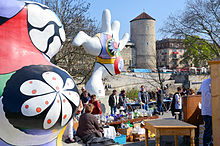Nana (plastic)



Nanas are sculptures by the French artist Niki de Saint Phalle (1930–2002), which use the imagery of Pop Art to depict sensual, colorfully designed, voluminous female bodies with oversized gender characteristics.
" Nana " is an ambiguous term from French for a modern, self-confident, erotic and wicked woman. In the mid-1960s, Niki de Saint Phalle anticipated the ideas of the women's movement with the saying “All power to the Nanas!” . Her oversized female sculptures were exhibited for the first time in October 1965 in Paris. The life-affirming, happy, colorful, mostly dancing, often larger than life, fat “Nanas” run through her further work. In 1968/69 the Black Nana was created in the Wallraf-Richartz Museum and in 1994 in the Museum Ludwig the Nana on a dolphin . The Nanas initially stand for vitality, femininity, free design without inhibitions and conventions, they unite all women in themselves, are a comprehensive reflection of the female existence.
She realized her greatest “Nana” together with Jean Tinguely in 1966 in front of the Stockholm Moderna Museet . Hon - en katedral (Swedish: you - a cathedral ) is what they called the 29 meter long sculpture of a woman's body that could be explored through the vagina. This “nana” housed a cinema, a love niche in the leg, a milk bar in the chest and a mechanical uterus in the stomach. This was also Niki's ironic comment on the traditional ideal of women.
In 1974, three colorful, voluminous “Nanas” made of polyester were set up on the Leibnizufer der Leine in Hanover . They became the cornerstone of the later Hanover Sculpture Mile . The lineup initially led to storms of protest, but also triggered the first discussion about art in public street space . Ultimately, they provided the decisive impetus for an intensive discussion about art as a form of everyday culture .
literature
- Charlotte Ueckert : Niki de Saint Phalle. Round women magician. A portrait. Philo & Philo Fine Arts, Hamburg 2007, ISBN 978-3-86572-540-0 .
- Ursula Gast: Dissociation between disorder and healing using the example of Nanas by Niki de Saint Phalle. In: Udo Schneider (Ed.): Aspects of the psychic. Festschrift on the occasion of the 60th birthday of Hinderk M. Emrich. Königshausen & Neumann , Würzburg 2004, ISBN 3-8260-2729-9 , pp. 39-44 ( online at Google books ).
- Ines Katenhusen : lust for life by council resolution. The street art experiment and the Nana scandal in Hanover in the 1970s. In: Daniela Münkel , Jutta Schwarzkopf (ed.): History as an experiment. Studies on politics, culture and everyday life in the 19th and 20th centuries , Festschrift for Adelheid von Saldern , Frankfurt / Main; New York: Campus-Verlag, 2004, ISBN 3-593-37489-7 , pp. 307-319
- Ines Katenhusen: Nanas. In: Klaus Mlynek, Waldemar R. Röhrbein (eds.) U. a .: City Lexicon Hanover . From the beginning to the present. Schlütersche, Hannover 2009, ISBN 978-3-89993-662-9 , p. 459.
- Helmut Knocke , Hugo Thielen : Nanas. In: Hannover Art and Culture Lexicon , pp. 40, 44, 166
Web links
- Panorama photo: Three "Nanas" on Leibnizufer in Hanover (2005)
- Photo: "Nana on the dolphin" in front of the theater in the harbor in Hamburg (2011)
- Photo: "Hon - en katedral" ( Memento from December 4, 2012 on WebCite ) in the Moderna Museet in Stockholm (1966)